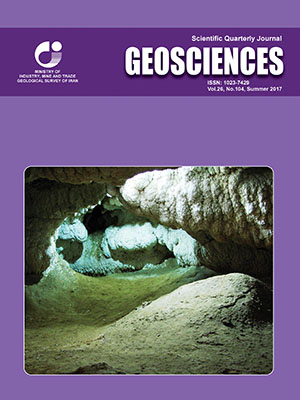References
Brenan, J. M., Shaw, H. F., Phinney, D. L. and Ryerson, F. J., 1994- Rutileaqueous fluid partitioning of Nb, Ta, Hf, Zr, U and Th: Implications for high field strength element depletions in island arc basalts: Earth and Planetary Science Letters, v. 128: p. 327–339.
Cox, K. G., Bell, J. D. and Pakhurst, R. J., 1979- The Interpretation of Igneous Rocks, London, Allen and Un- Win, 450.
Davidson, J. P., 1996- Deciphering mantle and crustal signatures in subduction zone magmatism: Geophysical Monograph 96: p. 251–262.
De Hoog, J. C. M., Mason, P. R. D. and van Bergen, M. J., 2001- Sulfur and chalcophile elements in subduction zones: Constraints from a laser ablation ICP-MS study of melt inclusions from Galunggung Volcano, Indonesia: Geochimica et Cosmochimica Acta, v. 65: p. 3147–3164.
Foley, S. F., Barth, M. G. and Jenner, G. A., 2000- Rutile/melt partition coefficients for trace elements and an assessment of the influence of rutile on the trace element characteristics of subduction zone magmas: Geochimica et Cosmochimica Acta, v. 64: p. 933–938.
Hassanpour, S. and Alirezaei, S., 2013- Studies in economic geology and age assesmentmethod (Ar/Ar) deposits copper-gold porphyry Masjeddaghy: 32th National and 1th International Geosciences Congress, Geological survey of Iran.
Irvine, T. N. and Baragar, W. R. A., 1971- A guide to the chemical classification of common volcanic rocks. Canadian Journal of Earth Sciences, 8, 523-548.
Pearce, J. A., Harris, N. B. W. and Tindle, A. G., 1984- Trace element discrimination diagrams for the tectonic interpretation of granitic rocks", Journal of Petrology, 25, 956-983.
Peccrillo, A. and Taylor, S. A., 1976- Geochemistry of Eocene calc-alkaline volcanic rocks from the Kastamonu area, Northern.
Renne, P. R., Swisher, C. C. III, Deino, A. L., Karner, D. B., Owens, T. and DePaolo, D. J., 1998- Intercalibration of standards, absolute ages and uncertainties in 40Ar/39Ar dating. Chem Geol., 145(1–2):117–152.
Shand, S. J., 1943- Eruptive Rocks: Their Genesis, Composition, Classification, and Their Relation to Ore-Deposits with a Chapter on Meteorite, New York: John Wiley and Sons.
Sillitoe, R. H. and Perelló, J., 2005- Andean copper province: Tectonomagmatic settings, deposit types, metallogeny, exploration, and discovery: Hedenquist, J. W., Thompson, J. F. H., Goldfarb, R. J., and Richards, J. P., eds., Economic Geology 100th Anniversary Volume, p. 845–890.
Stocklin, J. and Setudehnia, A., 1972- Lexique Stratigraphique International Volume III, ASIE centnational de la Recherche scientifique. 15 quai Anodle-France 75 (paris-VII), Geological Survey of Iran, Report no. 18, second edition, 376 p
Sun, S. S. and McDonough, W. F., 1989- Chemical and isotopic systematics of oceanic basalts: Implications for mantle composition and processes. In: Saunders, A.D., and Norry, M.J., )od( Magmatism in the ocean basins, Geologred Society, London. spec. pub., 42, 313-345.
Tatsumi, Y., Hamilton, D. L. and Nesbitt, R. W., 1986- Chemical characteristics of fluid phase released from a subducted lithosphere and the origin of arc magmas: Evidence from high pressure experiments and natural rocks: Journal of Volcanology and Geothermal Research, v. 29: p. 293–309.
Titley, S. R. and Beane, R. E., 1981- Porphyry copper deposits, Part 1. Geologic settings, petrology, and tectonogenesis: Economic Geology, 75th Anniversary Volume, 214-235.
UN (United Nations), 2000- Metallogeny of northern Azerbaijan.
Wood, D. A., 1980- The application of a Th-Hf-Ta diagram to problems of tectonomagnetic classification and to establishing nature of basaltic lavas of the British Tertiary Volcanic Province. Earth and Planetary Science Letters: 50, 11–30.

